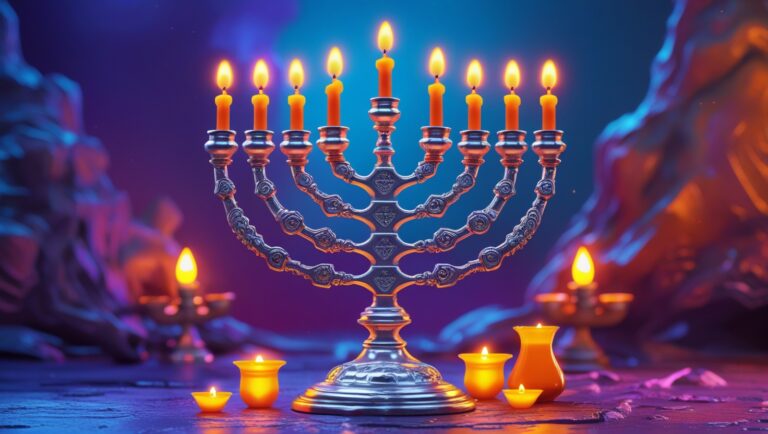Brit Milah (circumcision) holds a central place in the hearts of Jews, as emphasized in the Talmud.
It is arguably one of the most widely performed Mitzvot since even non-religious Jews make a strong effort to perform it in their children. In Nedarim 31, the sages teach that even Avraham Avinu, who was unparalleled in his zeal to fulfill God’s commandments, was called “perfect” only after performing Brit Milah. The verse states, “Walk before Me, and be perfect” (Genesis 17:1), underscoring that Milah is not merely a physical act but a transformative spiritual milestone.
The Zohar stresses the heavy spiritual weight of Brit Milah by connecting it to the totality of the Torah’s mitzvot. The numerical value of the word Brit (ברית) is 612, corresponding to the 612 mitzvot of the Torah when combined with the singular mitzvah of Brit Milah itself. This equivalence indicates that Brit Milah serves as a gateway or foundation for fulfilling all the commandments of the Torah.
Together with the Korban Pesach, this is one of the 2 Positive Mitzvot for which a man is punished with Karet (spiritual excision) for not actively performing it (after reaching the age of 13).
The sages proclaim that Brit Milah is so fundamental that it underpins the very existence of heaven and earth. As it is written, “Were it not for My covenant, I would not have created day and night, the laws of heaven and earth” (Yirmiyahu 33:25). This statement, cited in Talmud Shabbat 137b, reveals the tremendous significance of this mitzvah, illustrating that Brit Milah is not merely a ritual—it is an essential bond between God and creation.
Preserving the Sacred Tradition
Sadly, deviations in the performance of Brit Milah have raised concerns among rabbis and observant communities. It is absolutely vital to safeguard the authenticity of this mitzvah, as it has been transmitted faithfully through generations from Moshe Rabbeinu, who received the tradition directly from the Holy One, Blessed be He, no matter what politicians or educators have to say about it.
The proper performance of Brit Milah, as handed down from Mount Sinai, involves three distinct steps:
- Cutting the Foreskin: This is performed with an iron knife, as required by halachah.
- Periah (Peeling Back the Skin): The mohel uses their nails to separate and pull back the underlying membrane, ensuring this is done manually rather than cutting it along with the foreskin.
- Metzitzah (Suctioning the Blood): The mohel must draw the blood orally from the site of the incision, fulfilling a sacred component of the mitzvah.
Each element of the process is a Tikkun in and of itself, which will enable the baby’s soul to draw down the Chassadim to the Yesod and sweeten the Dinim. This is not a trivial matter.
In recent times, certain Mohels have begun altering the holy process of Brit Milah, which they will need to answer for in Heaven. These changes include:
- Neglecting the Mitzvah of Periah: Some Mohels cut the foreskin and the membrane of the Periah together, rather than peeling back the membrane separately with their fingernails as halachah requires.
- Omitting Metzitzah: Others completely disregard the mitzvah of drawing the blood orally.
Such alterations undermine the essence of Brit Milah, a mitzvah for which countless generations of Jews were willing to give their lives for. Without any external coercion, these new practices deviate from the time-honored traditions upheld by our ancestors, casting doubt on the mitzvah’s validity and sanctity. The Talmud underscores the gravity of these omissions: “Mal velo parah ke’ilu lo mal”—if the Periah is not performed, it is as though the Brit Milah was not done at all (Talmud Shabbat 137b). When Metzitza is omitted, the impure blood stays inside the baby, and will affect him negatively for the rest of his life.
Guidance for Parents: Selecting a Mohel
The responsibility to ensure the proper performance of Brit Milah rests on the parents. Before entrusting a Mohel with this holy act, parents should inquire about the Mohel’s adherence to tradition. Specifically, they should confirm that the Mohel:
- Follows the received tradition for Periah, manually peeling back the membrane with their nails.
- Performs Metzitzah by suctioning the blood orally, in accordance with halachic requirements.
- Ideally the Mohel should also be versed in the Kavanot of Brit Milah
The Shulchan Aruch (Yoreh Deah 264:1) advises that one must seek out a Mohel who is both skilled and righteous. The Rema cites the Or Zarua, emphasizing the importance of choosing a Mohel who not only performs the mitzvah with precision but also embodies spiritual integrity. A Mohel who deviates from tradition, disregarding Periah and Metzitzah, fails in both halachic observance and moral character, and therefore cannot be considered suitable for this sacred task.
The Importance of Periah with Fingernails
Throughout Jewish history, esteemed Poskim and Mekubalim have emphasized the necessity of performing Periah—the tearing and folding back of the thin membrane beneath the foreskin—using fingernails. Below are some statements from leading authorities that affirm and explain the importance of keeping this tradition:
- Rabbeinu Yaakov Ha-Gozer (Baalei Tosafot)
Rabbeinu Yaakov, one of the Baalei Tosafot, recorded:
“I have received the tradition that the Periah must be performed specifically with the fingernails. It is a sacred element of the mitzvah. Anyone who performs the Periah without tearing the fine membrane with fingernails is acting against Halacha. This method has been transmitted through our forefathers and must not be altered.”
(Rabbeinu Yaakov Ha-Gozer, Responsa on Hilchot Milah, section 19) - The Ari HaKadosh and Rabbi Chaim Vital
Rabbi Chaim Vital recounts the teachings of his master, the Arizal, regarding the mystical dimensions of Periah:
“After cutting the foreskin and discarding it, the thin membrane beneath—known as the skin of the Periah—must be torn, not cut. The skin of the Periah is imbued with sanctity and must therefore not be treated in the same manner as the foreskin. The tearing must be done delicately and purposefully, following the tradition of our forefathers.”
(Rabbi Chaim Vital, Shaar HaKavanot, Brit Milah) - Rabbi Moshe Cordovero (Tikkunei Zohar)
The Ramak explains the dual structure of the mitzvah:
“The mitzvah of Brit Milah is divided into two parts. The first part is the cutting of the foreskin (Orlah), which represents the removal of the coarse barrier separating man from divine connection. The second part is the tearing of the Periah. This must be done specifically with the fingernails, as it symbolizes the refinement and sanctification of the physical body. Cutting the Periah alongside the foreskin undermines its unique spiritual role.”
(Rabbi Moshe Cordovero, Tikkunei Zohar, Part 3, p. 232) - Rabbi Chaim ben Attar (Or HaChaim)
Rabbi Chaim ben Attar underscores the importance of performing all three components of Brit Milah—Milah, Periah, and Metzitzah:
“The mitzvah of Brit Milah includes three integral steps: the removal of the foreskin (Milah), the tearing of the thin membrane (Periah) with the fingernail, and the drawing out of impure blood (Metzitzah). These steps reflect the covenant in its full spiritual and physical expression, and any omission risks invalidating the mitzvah. The Periah must specifically be performed with the fingernail, as the act embodies the removal of subtle spiritual obstructions.”
(Rabbi Chaim ben Attar, Or HaChaim, Parashat Tazria) - Rabbi Yishmael HaCohen (Zerah Emet)
Rabbi Yishmael HaCohen asserts that the mitzvah of Periah is Halacha transmitted directly from Sinai:
“Even in cases of adult circumcision, the mitzvah of Periah is required. This is not merely a custom but a Halacha transmitted to Moshe at Sinai (Halacha L’Moshe MiSinai). It is explicit in our sacred traditions that the Periah must be torn precisely with the fingernail. If this step is omitted, the Brit Milah is incomplete.”
(Rabbi Yishmael HaCohen, Zerah Emet, Yoreh Deah, Siman 132) - Zecher David (Rabbi Yitzchak Luria)
Drawing on Kabbalistic symbolism, the Arizal’s disciple explains:
“The fingernail represents the kelipah, the outer shell that must be used to annul the strength of the Orlah. By performing the Periah with the fingernail, we ensure the spiritual victory over impurity and elevate the act of circumcision beyond the physical realm.”
(Rabbi Yitzchak Luria, Zecher David, Maamar Aleph, 21) - Zocher HaBerit
The author of Zocher HaBerit warns against those who attempt to undermine sacred traditions:
“The Periah must be performed with the fingernails, as written by Rambam, Sefer Mitzvot Gedolot, and Or Zarua. This tradition is also supported by our Holy Midrashim. Do not heed the words of those who claim to be scholars but seek to annul Israel’s sacred customs. Every detail of this mitzvah is rooted in holiness and established on the foundations of Torah.”
(Zocher HaBerit, Siman 11, Letter 16) - Rabbi Nachman of Breslov (Sefer Berit Shalom)
Rabbi Nachman provides deep mystical insight into the dual nature of the foreskin (Orlah) and the necessity for both cutting and tearing:
“The Orlah comprises two Kelipot [husks], Esav and Yishmael. Therefore, we require both cutting and tearing to address these forces. First, we cut the foreskin (Orlah) entirely to eliminate the Kelipah of Esav, which is completely impure. Then, the Kelipah of Yishmael, being associated with Kelipat Nogah [a mixture of good and bad], is not destroyed but rather rectified through the act of tearing, which integrates it back into the body.”
(Sefer Berit Shalom, Rabbi Nachman ZTK”L) - The Vilna Gaon (Commentary on Tikkunei Zohar)
The Vilna Gaon emphasizes the mystical significance of the Periah:
“Within the Orlah itself, there are three Kelipot that must be entirely removed during the cutting. However, the act of Periah involves the finer membrane, which does not require elimination but separation and incorporation into the surrounding skin. This process rectifies the inner forces and aligns them with holiness.”
(Hagahot on Tikkunei Zohar, Tikkun 37, Vilna Gaon ZTK”L) - Rabbi Moshe Schick (Maharam Schick)
The Maharam Schick highlights the divine origin of the mitzvah of Periah:
“Who can fathom the secrets of the Creator? He instructed us to cut the Orlah entirely and also commanded us through a Halacha le-Moshe mi-Sinai to tear the thin membrane. It is explicitly stated that this fine skin should not be cut but torn to fulfill the mitzvah of Periah properly.”
(Sheelot u-Teshuvot Maharam Schick, Yoreh Deah, Siman 245) - Rabbi Elchanan Wasserman
Rabbi Wasserman provides textual support for the practice of Periah with fingernails:
“The Rambam clearly wrote that the Periah must be performed with the fingernails, and its source is found in the Aggadah. This serves as evidence of the transmission of this practice from earlier sages, solidifying its authenticity as part of the tradition handed down from the Rabbanim.”
(Kobetz Shiurim, Yevamot 64:8, Rabbi Elchanan Wasserman ZTK”L) - Rabbi Yaakov Etlinger (Binyan Tzion)
Rabbi Etlinger stresses the ancient and universal acceptance of the practice of Periah with fingernails:
“The method of performing the Periah with the fingernails is widely known and has been universally accepted throughout all Jewish communities. It is evident that this tradition was received directly from Moshe Rabbeinu, alongside the Mishna, as part of our unbroken chain of transmission.”
(Sheelot u-Teshuvot Binyan Tzion, Siman 85, Rabbi Yaakov Etlinger ZTK”L) - Koret Ha-Brit (Hilchot Milah)
Koret Ha-Brit strongly advocates preserving the traditional practices of Milah:
“G-d forbid that we should ever deviate from our sacred traditions. The mitzvah of Periah must always be performed with the fingernails, as passed down by our forefathers. This is not merely a ritual but a divine command that reflects the spiritual rectifications unique to Milah.
(Koret Ha-Brit, Hilchot Milah, Siman 264)
Kavanot of Brit Milah
Below are some of the Kavanot for the Brit Milah. The Shemen Sasson writes that even if the one performing the Mitzvah or Tefilah does not use them, the fact that someone else does helps effect the Tikkun (which should be mind-boggling).
Kavanah of the Milah
Kavanah of the Periah:
Kavanah of the Metzitzah:
I don’t think we need to discuss the fact that the Kavanot are a highly overlooked factor that will bring many awesome benefits to the baby throughout life.
The Holy Covenant Brings Stability to the World
The Zohar highlights the cosmic stability achieved through the observance of the Brit Milah:
“As long as Israel observe the Holy Covenant, they cause stability in the world, both above and below. However, when they forsake the Covenant, there is no stability either above or below. Those who remain attached to this Covenant and do not forsake it ensure that no race or tongue can harm them. Yet, neglecting the Covenant incurs Divine anger, as it is written: ‘A sword that will execute the vengeance of the Covenant’ (Leviticus 26:25).
(The Holy Zohar I, 66b)
Similarly, Tikkunei Zohar warns of the consequences of forsaking the Brit:
“When Israel do not guard the Brit Milah, the idolatrous nations gain power over them and are likened to ‘proud waters,’ as in the verse: ‘Then the proud waters would have gone over our soul‘ (Psalms 124:5).
(Tikkunei Zohar 13)
The Mishnah also underscores the eternal significance of the Brit:
“One who breaks the Covenant of Abraham Avinu, even if he has Torah and good deeds, has no portion in the World to Come.” (Pirkei Avot 3:15)
Through the Blood of the Child at the Brit Milah, the World Is Dealt With Kindness
Rabbi Shimon Bar Yochai reveals the mystical impact of the Brit Milah in bringing mercy to the world:
“A man who begets a son becomes linked with the Shechinah, which is the gateway to all the heavenly doors. The blood that flows from the child is preserved before the Almighty, and when punishment impends over the world, G-d looks at that blood and delivers the world [from evil]. We have learned that through this blood, the world is based on loving-kindness (Chessed), and all worlds are established.”
In the Zohar Rabbi Shimon also connects the Covenant to two celestial crowns:
“There are two Crowns linked together, they being the gateway to all other Crowns: one is Justice, and the other is Mercy. This Covenant binds both attributes—Chessed and Judgment—uniting them as ‘day and night.’ Thus, one who keeps this Covenant without fail takes hold of both realms and is rewarded in two worlds: this world and the World to Come.”
(The Holy Zohar, Vayikra 14a)
May we merit to safeguard the Brit Milah and always perform its Mitzvah in the most optimal manner.







